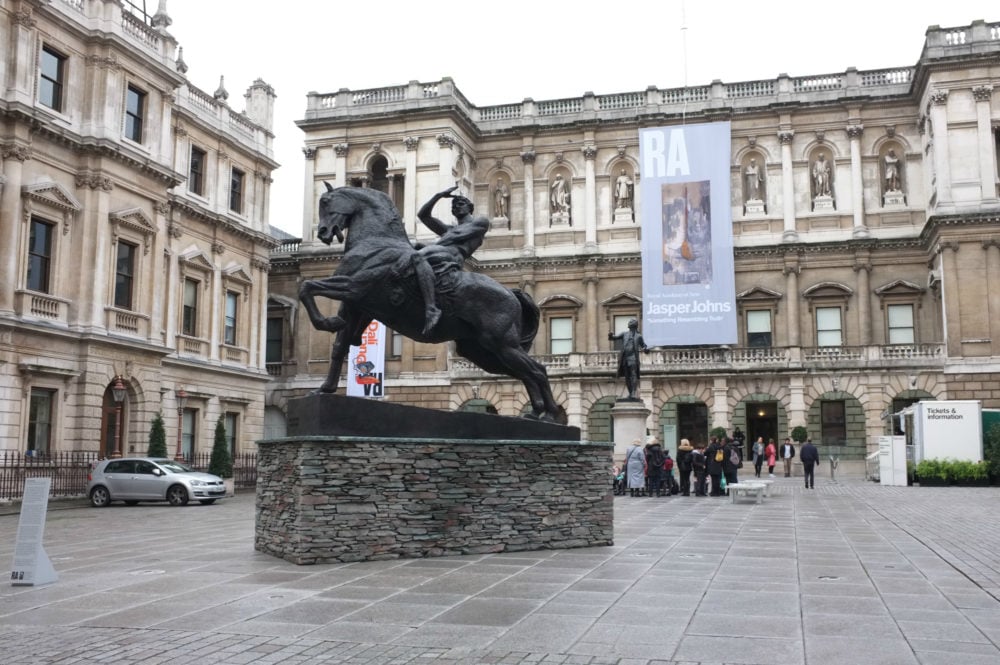
The Victorian artist George Frederic Watts’s late, great equestrian statue Physical Energy returned to the courtyard of London’s Royal Academy (RA) on Monday, November 20, more than a century after it was first exhibited there. The rearing horse and rider comes with baggage, however. Physical Energy has been associated with the gung-ho British imperialist and white racist Cecil Rhodes ever since it was first cast in bronze in 1904.
Watts (1817–1904), who was the first living artist to have a solo show in New York’s Metropolitan Museum of Art, also painted Hope (1885–86), an image of a blindfolded young girl that inspired both Barack Obama and Martin Luther King. Watts’s humanitarianism and social sympathies had their limits, however, and Africa was among blind spots, or he chose to turn a blind eye to the exploitation of its black population.
George Frederic Watts, Hope (1886). Public domain, courtesy Wikimedia Commons.
The new bronze cast of the sculpture, now on show at the RA (until March 30), has been commissioned by the Watts Gallery Trust to mark the 200th anniversary of the artist’s birth.
Earlier this year, a new book titled The Art of G.F. Watts by Nicholas Tromans, who is the curator of the Watts Gallery–Artists’ Village, reveals that Watts was a willing, if muddle-headed, supporter of Rhodes.
In 1901, at the height of the Second Boer War in South Africa—which Rhodes did much to bring about—Watts dismayed some of his admirers when he wrote an essay that Tromans describes as “frankly, terrifying.” Called “Our Race as Pioneers,” the text argues that the Boers, who were the descendants of Dutch settlers, must be defeated in the name of progress; the British require greater living space around the world, and it was the nation’s duty to expand its “progressive” colonial rule around the world.
Watts’s tribute to Rhodes’s “genius” is inscribed on the latter’s memorial overlooking Cape Town. Physical Energy forms the centerpiece to the monument that commemorates the diamond mogul-turned-politician who wanted to build a railway from Cape Town to Cairo and claim mineral rights along the way. Some historians see him as an architect of Apartheid in the way he denied black Africans land and political rights.
Watts, like Rhodes, believed in British imperial might to back its right to rule. Tromans reveals the artist “plied” a leading politician with suggestions that military service should be introduced. (The colonial statesman Lord Grey was the man who suggested Watts turn the equestrian sculpture into a memorial to Rhodes after he died, aged 49, in 1902.)
Tromans stresses that Watts’s imperialism was “liberal” and that the sculpture’s ideological meaning is open-ended. Socialists used the image, too. In fact, Watts had multicultural references in mind when he first conceived the statue: It was due to be dedicated to great empire builders including Mohammed, Attila the Hun, and Genghis Kahn. (Trowmans adds that May Watts, the artist’s second wife and a fellow artist, was much more sceptical of Rhodes.)
The new bronze cast of Physical Energy—like its other version in London’s Kensington Gardens—is shorn of these references. After its display at the RA, it’s due to be erected on a hill near the Watts Gallery, the home and gallery the artist built in Surrey. The plan for its installation is due to go ahead next year, subject to planning permission and ongoing fundraising.